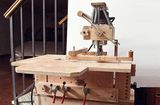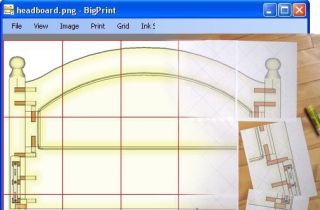Tony's Router pantograph
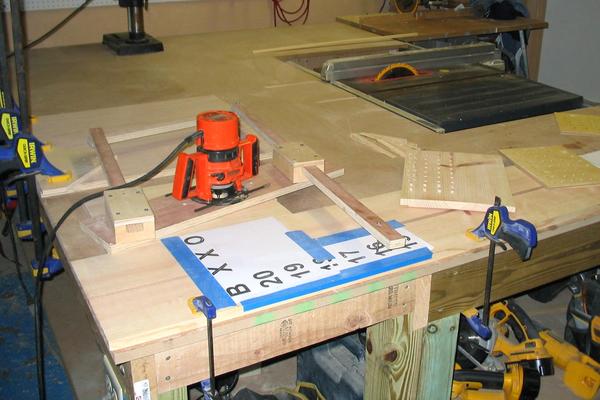
Tony Raunikar writes:
"I wanted a simple machine to trace lettering so I could rout numbers into a scoreboard for a dart board cabinet that I built, but there were no plans on the internet and I didn't want to spend $70 on this so I made my own. I used 3/4" plywood that I had in my shop and some odds and ends that I found in my junk drawer.
The guide rails are 34" plywood ripped down to 1 1/4". I used this width because the scrap of plywood that I had was only big enough to accommodate this width.
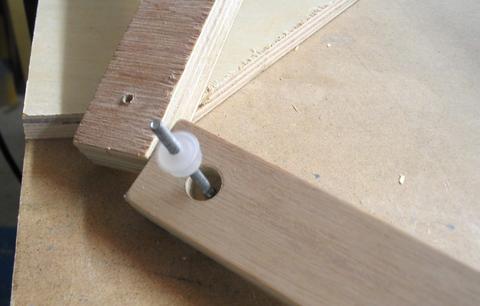 The pivot, articulating arms, and guide are 6-32 screws 2 1/2" long that I had in my screw bin.
I chose this size because it happened to thread nicely into the plastic buttons (that I happened
to have in my junk drawer) and they were the only screws that I had that were long enough to
raise the rear rails off the table 3/4".
The pivot, articulating arms, and guide are 6-32 screws 2 1/2" long that I had in my screw bin.
I chose this size because it happened to thread nicely into the plastic buttons (that I happened
to have in my junk drawer) and they were the only screws that I had that were long enough to
raise the rear rails off the table 3/4".
I was going to use wooden buttons and drill a hole in them until I ran across these plastic ones. These buttons act as a friction bearing between the articulating guide arms as shown in these pictures.
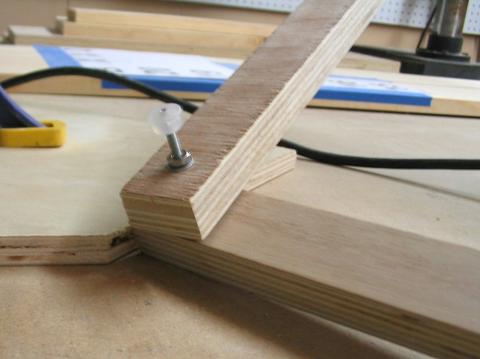 The button on the bottom of the screw allows it to slide easily along the bench during the
routing process. I drilled a 3/8" counter bore into the upper guide arm for the button to
seat in. This made for a really smooth articulating elbow.
The button on the bottom of the screw allows it to slide easily along the bench during the
routing process. I drilled a 3/8" counter bore into the upper guide arm for the button to
seat in. This made for a really smooth articulating elbow.
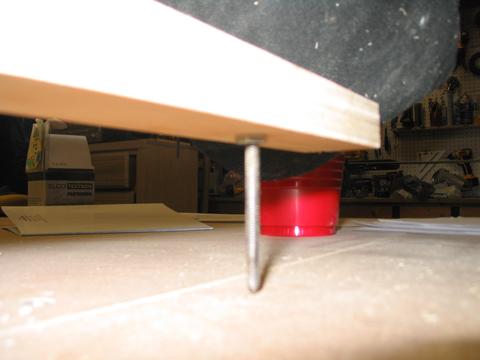 The guide is a 6-32 screw the
same length with the tip ground down a little for more pinpoint accuracy. Don't grind it to
a point or it will tear the paper template while sliding across it.
The guide is a 6-32 screw the
same length with the tip ground down a little for more pinpoint accuracy. Don't grind it to
a point or it will tear the paper template while sliding across it.
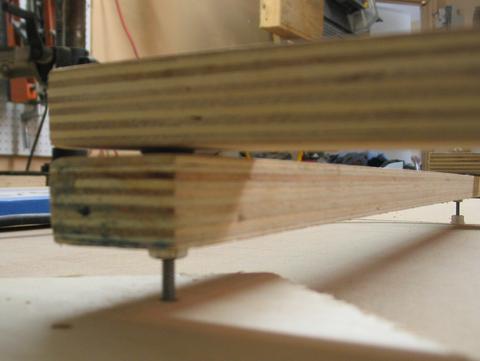 The pivot arm assembly is exactly the same as the others except there is no button
on the bottom of the screw. The pivot has to be stationary so the button would not be necessary.
The pivot arm assembly is exactly the same as the others except there is no button
on the bottom of the screw. The pivot has to be stationary so the button would not be necessary.
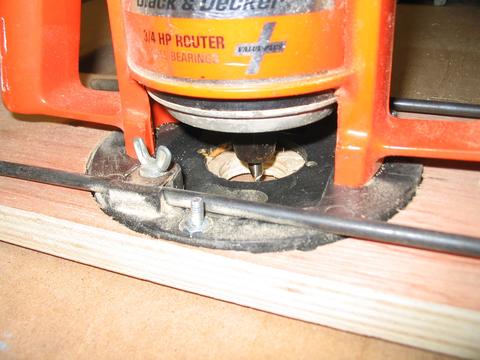 I made the router base out of the left over piece of plywood after ripping the rails down. I had this old B&D
router under my bench for years and only used it for quick work so I decided to fabricate the base
to fit this router. It is lighter than my plunge router and I don't mind leaving it mounted to
the machine as I rarely used it anyway.
The contraption hangs nicely on my pegboard so storage is not a problem.
I made the router base out of the left over piece of plywood after ripping the rails down. I had this old B&D
router under my bench for years and only used it for quick work so I decided to fabricate the base
to fit this router. It is lighter than my plunge router and I don't mind leaving it mounted to
the machine as I rarely used it anyway.
The contraption hangs nicely on my pegboard so storage is not a problem.
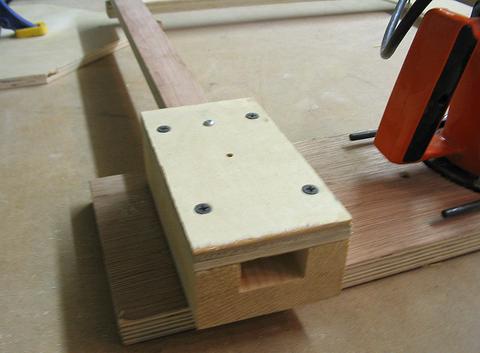 The guide rail adjustment is just a 2x4 ripped to 3" and dadoed out to accommodate the guide arm.
This adjustment, as it turns out, is probably not necessary as the 2 to 1 reduction of the pantograph is
already small enough.
The guide rail adjustment is just a 2x4 ripped to 3" and dadoed out to accommodate the guide arm.
This adjustment, as it turns out, is probably not necessary as the 2 to 1 reduction of the pantograph is
already small enough.
 You can see how big the lettering has to be to make reasonable sized routed letters.
The printed lettering is 1 1/2" high yielding a 3/4" high routed letter. Any smaller and they wouldn't
have been legible. If anything the adjustment should be able to move closer to the guide, increasing the
size of the routed letters. These guide rails adjustments are capped with 1/2" plywood and they pivot on
a 1 5/8" drywall screw. I put 2 fender washers between the router base and the guide rail adjustment to
act as a friction bearing as well. I used fender washers instead of buttons because I wanted a larger
surface for the guide rail adjustment to rotate around. This articulation arm also supports the weight
of the router so I didn't want it tilting, it just has to pivot in one direction.
You can see how big the lettering has to be to make reasonable sized routed letters.
The printed lettering is 1 1/2" high yielding a 3/4" high routed letter. Any smaller and they wouldn't
have been legible. If anything the adjustment should be able to move closer to the guide, increasing the
size of the routed letters. These guide rails adjustments are capped with 1/2" plywood and they pivot on
a 1 5/8" drywall screw. I put 2 fender washers between the router base and the guide rail adjustment to
act as a friction bearing as well. I used fender washers instead of buttons because I wanted a larger
surface for the guide rail adjustment to rotate around. This articulation arm also supports the weight
of the router so I didn't want it tilting, it just has to pivot in one direction.
I found that the distances between all of these pivot points had to be exactly the same for the reduction to be exactly 2 to 1 and the height and width ratio to stay the same. I chose 16" center to center. This worked out to be a good decision. So the distance between the pivot points is 16" and the distance from the guide to the pivot is also 16".
 The setup was a bit cumbersome to figure out and in the future I will make a dedicated frame for
this but for now I just clamped some scrap plywood to my bench as shown in this picture.
The setup was a bit cumbersome to figure out and in the future I will make a dedicated frame for
this but for now I just clamped some scrap plywood to my bench as shown in this picture.
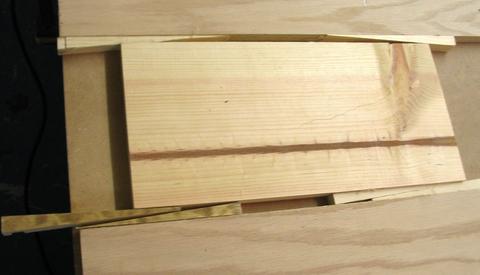 After aligning the workpiece to the template I cut some wedges to secure it as shown in
this picture.
After aligning the workpiece to the template I cut some wedges to secure it as shown in
this picture.
 The finished product is shown in this picture. The first time my buddies came
over they pointed out that I had omitted the bulls eye score on the board, so since I didn't
have any more wood at that time I just set it back up and routed the "B" in front of the
hashes. Looks funny but it works. Next time I have some more 1x12 I will re-route these
scoreboards but for now were throwing darts.
The finished product is shown in this picture. The first time my buddies came
over they pointed out that I had omitted the bulls eye score on the board, so since I didn't
have any more wood at that time I just set it back up and routed the "B" in front of the
hashes. Looks funny but it works. Next time I have some more 1x12 I will re-route these
scoreboards but for now were throwing darts.
See also:
More Reader projects
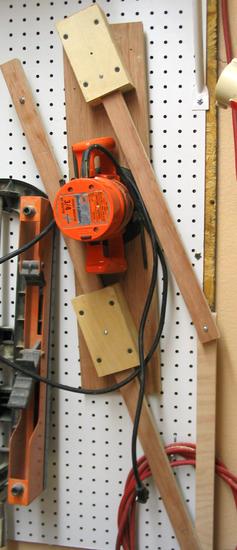
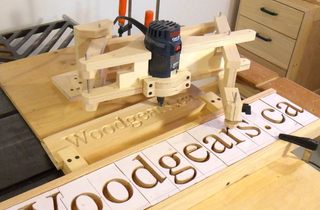 3D rotuer pantograph
3D rotuer pantograph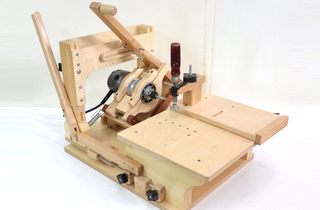 The pantorouter machine
The pantorouter machine